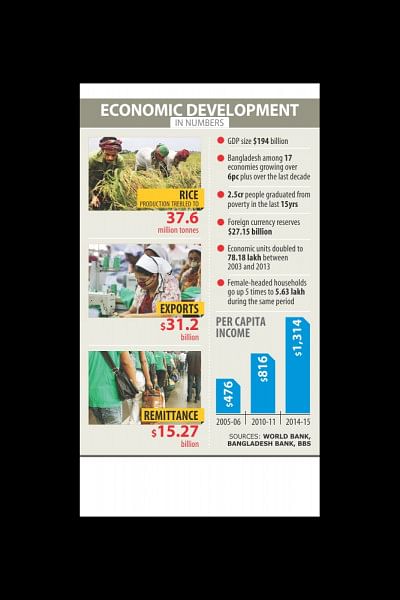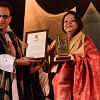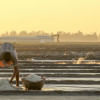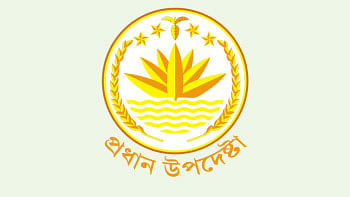Stellar growth

Bangladesh is now one of the fastest growing economies in the world, riding on a stellar performance of the manufacturing sector and hard work of farmers and migrant workers.
Out of 58 countries with a population of at least 20 million each, only 17, including Bangladesh, China, India and Sri Lanka, achieved an average GDP growth of six percent and more, shows the World Bank's analysis of growth performance of countries in a decade till 2014.
Intermittently hit by sundry challenges, Bangladesh rose from the ashes of a nine-month-long bloody war to become what it is today.
Its economy has been growing at more than six percent for over a decade, with the International Monetary Fund projecting the growth to accelerate gradually to seven percent over the medium term.
In July last year, the country graduated to a lower middle income nation from a low income one.
According to government statistics, Bangladesh's per capita income now stands at $1,314. And the government aims to almost treble it to over $4,000 by 2021.
This economic success of Bangladesh has led many to predict a bright future for the country in the days to come.
MoneyGram, a US-based money transfer company, has included Bangladesh in its list of five fast-growing economies in the world.
Brooking Institutions, a US-based thinktank, said Bangladesh's economy is 34th in the world in terms of size. In the next 25 years or so, it will become 23rd, surpassing that of many European countries, Australia and Malaysia in terms of size.
“The most important driver of Bangladesh's growth has been capital accumulation in the early stage of development,” said Zahid Hussain, WB lead economist in Dhaka.
Capital accumulation, financed mostly out of national savings, enabled the expansion of production capacity in agriculture as well as industry, he said.
Prudent macroeconomic management, financial sector reforms, deregulation, trade liberalisation and inclusive social policies contributed to the creation of an environment congenial for investment.
“Although this average growth of six percent is described by many as a trap, it put Bangladesh among the fastest growing countries in the world during 2004-14,” he said.
In December, WB Chief Economist Kaushik Basu said he is more upbeat about Bangladesh, adding that the country is on the cusp of a take-off and will become one of the new Asian Tigers.
“Now it is time for the people of Bangladesh to feel that they have the reason to be ambitious.” The progress will be more rapid if people realise that it is possible to grow faster onwards, he said.
Basu's visit coincided with the prime minister's inauguration of the construction work of Padma bridge for which the WB promised $1.2 billion in credit but later cancelled it over allegations of corruption conspiracy in the project.
He said it was unimaginable 10 years ago that Bangladesh could undertake a project of this scale. But the country now has the means and capacity to pull off such an ambitious project.
At a programme in the capital on Wednesday, Finance Minister AMA Muhith said poverty rate has fallen sharply in the country, with 130 million of 160 million people now living above the poverty line.
“This was possible because of domestic demand. It has also helped keep the pace of economic growth over six percent despite a tumultuous global scenario,” he said.
According to planning ministry data, around 25 million people graduated from the poverty line since 2000.
Rice production has trebled since 1980, from 12.3 million tonnes to 37.6 million tonnes.
The manufacturing sector, led by apparel, has been the single largest contributor to growth, with its share in GDP reaching 17 percent last year from 13 percent in 1981.
In 1972-73, war-torn Bangladesh's export was $348 million only. In the last fiscal year, it stood at $31.2 billion.
Exports, which account for around 20 percent of the country's gross domestic product, rose to a record high of $3.2 billion in a single month in December last year, while other regional economies reported continued decline in exports.
"Over the medium-to-long term, we are bullish on the growth prospects of Bangladesh's industrial and export sectors," Raphael Mok, Asia analyst of BMI Research, a company of credit rating agency Fitch Group.
During the Awami League government's tenure in 1996-2001, the country's foreign reserves fell below $1 billion. But the country now has more than $27 billion in reserves, enough to meet its import bills for seven months.
Remittance sent by migrant workers stood at $15.27 billion last year, which was only $781.54 million in 1990. Remittance income grew faster after 2008-09 on the back of a significant rise in manpower exports.
According to the government's latest economic census, the number of economic units doubled between 2003 and 2013, thanks to fast expanding non-farm activities across Bangladesh.
Economic units have increased 71 percent since 1986. Though still at a low level, the number of female-headed households increased five times since 2003 to 5.63 lakh in 2013.
Noted economist Wahiduddin Mahmud said it is clear that micro, small and medium enterprises are the main forces of the economy.
Rural families are no longer engaged in farm-based economic activities alone. More non-farm jobs have been created in rural areas compared to urban settings, he said.
Mohammed Farashuddin, former governor of the central bank, said the brighter side of the economy is that rural Bangladesh has healthy growth.
The average income of a village poor is now 10 times higher than that in 1972. “People are working. The country is full of non-farm activities,” he said.
Economist Hossain Zillur Rahman said new entrepreneurs are emerging. “Yesterday's full-time workers are opening economic units today. This is one of the pictures showing how the economy is flourishing.”
Selim Jahan, director of Human Development Report Office at the United Nations, sees vibrancy and dynamism within the country.
“Everybody is doing something. Somebody is selling fruits, somebody is selling clothes and somebody is doing something else. And that is not typical of Dhaka, that is typical of other cities as well,” said Selim.
As the country moves forward, it needs to focus on both physical and social infrastructure. “By neglecting one, sustainable growth and progress cannot be achieved.”
There is a consensus that Bangladesh can do better in terms of economic growth, given its strategic geographic location, vast young population and global connectivity.
To achieve growth rates similar to that of the East Asian stars such as China and South Korea, Bangladesh needs to work on easing the infrastructural and institutional constraints to raise private investment and efficiency of these investments, according to the WB.
Bangladeshis have never given up on their hopes despite a bitter relationship among major political parties, endemic corruption, infrastructure bottlenecks, weak institutions, fragile democracy and global slowdown.
It became evident again in January when an international survey by WIN-Gallup showed that Bangladeshis are the world's most optimistic people about their economic prospects in 2016.
In the survey, 66,040 people were interviewed across 68 countries, and the field work was conducted from September to December last year.

 For all latest news, follow The Daily Star's Google News channel.
For all latest news, follow The Daily Star's Google News channel. 








Comments